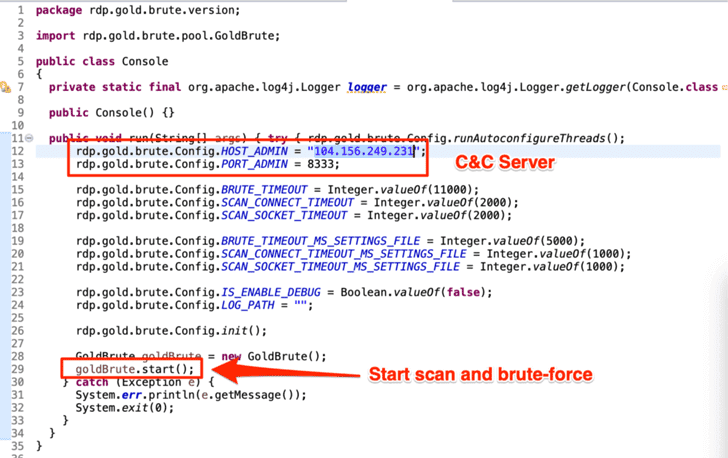GoldBrute botnet campaign is trying to hack 1.5 million RDP servers worldwide
New security researchers discover an ongoing sophisticated botnet campaign, using brute-force methods targeting more than 1.5 million publicly accessible Windows RDP servers on the Internet.
Named GoldBrute, botnet diagrams have been designed to gradually escalate, adding new cracked systems to its network, forcing them to find new available RDP servers and then proceed. brute-force.
To bypass security tools and malware analysts, attackers ordered each infected machine to target millions of servers with unique username and password sets. Therefore, servers will be brute-force attacked from different IP addresses.
This campaign was discovered by Renato Marinho at Morphus Labs. How it works is explained in the following steps:

Step 1 - After brute-force successfully an RDP server, the attacker installs the GoldBrute malware (based on JAVA) on the machine.
Step 2 - To control infected machines, the attacker uses a centralized, fixed command and control server to exchange commands and data via the WebSocket connection, which is encrypted with AES.
Steps 3 and 4 - Each infected machine then receives the first task of scanning and reporting a list of at least 80 new RDP servers that are publicly accessible and brute-force.
Steps 5 and 6 - The attacker then assigns each machine a unique set of usernames and passwords to perform the second task: using brute-force to attack the list of RDP targets that the system is infected with. continue to receive from C&C server.
Step 7 - When the test was successful, the infected machine reported the login information to the C&C server.
Currently, it is unclear exactly how many RDP servers have been compromised and involved in brute-force attacks against other RDP servers on the Internet.
According to The Hacker News, at the time of writing, a quick search by Shodan showed that about 2.4 million Windows RDP servers can be accessed on the Internet and perhaps more than half of these are being attacked.

Recently, security researchers have discovered two new security holes related to Remote Desktop Protocol (RDP), only one of which Microsoft patched, called BlueKeep.
BlueKeep (CVE-2019-0708) allows remote attackers to control RDP servers and if successfully exploited, can cause devastation around the world, potentially worse than those What WannaCry and NotPetya did in 2017.
The unpatched vulnerability in Windows could allow a client-side attacker to bypass the lock screen on remote desktop sessions (RD).
You should read it
- What is a botnet, who does it use to attack, and how can you prevent botnet?
- What is botnet DDoS?
- How the botnet works
- Microsoft dismantled the ZLoader botnet, naming key members as a deterrent
- Microsoft has just taken down a huge botnet network
- The US warned about DealtaCharlie - DDoS botnet malware from Korea
- Botnet Echobot spreads across a wide range, specifically targeting Oracle and VMware applications
- How to fix BlueKeep security error for Windows 2003, Windows XP, Windows 7, Windows Server 2008
- Hackers took control of 18,000 Huawei router devices in just one day
- How the botnet works (Part 2)
- Discovering botnets digging huge encrypted money earns $ 8,500 a day for hackers
- French police successfully cracked down on a botnet that exploits 850,000 computers from more than 100 countries.
May be interested

Find out about Ghidra - NSA's powerful cybersecurity tool

7 basic questions about firewalls everyone needs to know

Microsoft Azure is being used to host malware and C2 servers

GandCrab blackmail extinguished after earning $ 2.5 billion worldwide

Discovery of Trojan scattering steals virtual money through YouTube

The cybersecurity tools that every business should know






 ProFTPD remote code execution vulnerability affects more than 1 million servers worldwide
ProFTPD remote code execution vulnerability affects more than 1 million servers worldwide Discovering botnets digging huge encrypted money earns $ 8,500 a day for hackers
Discovering botnets digging huge encrypted money earns $ 8,500 a day for hackers Conficker's victim has reached 7 million
Conficker's victim has reached 7 million How the botnet works
How the botnet works What is a botnet, who does it use to attack, and how can you prevent botnet?
What is a botnet, who does it use to attack, and how can you prevent botnet? How to Detect and Mitigate Botnet Attacks
How to Detect and Mitigate Botnet Attacks